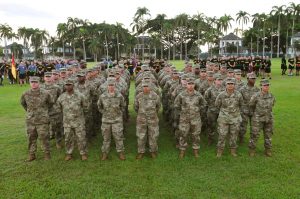By Francis P. Sempa

The United States’ Indo-Pacific strategy includes an important role for the ground forces of the U.S. Army. The Autumn 2020 issue of Parameters, the quarterly journal of the U.S. Army War College, includes an article by David M. Finkelstein, vice president of the Center for Naval Analyses and Director of the center’s China and Indo-Pacific Security Affairs Division, which briefly reviews the army’s historic role in the region, outlines the current geopolitical rivalries, notes the ongoing rebalance or “pivot” to East Asia and the Pacific, and suggests broad Army priorities for the region.
Finkelstein’s article should dispel the commonplace notion that American power and credibility in the Indo-Pacific wrests exclusively on U.S. naval and air power. The geography of the Indo-Pacific certainly requires a strong U.S. naval and air presence to project power and protect its security interests in the region. The series of island chains and marginal seas running along Asia’s east coast from Siberia to Indochina highlight the geopolitical importance of sea and air power. But Finkelstein contends that future deployments to the region should adhere closely to the “multi-domain operations concept.”
The author notes that in 2018, the Navy-led Rim of the Pacific (RIMPAC) exercise involved U.S. Army units engaging in land-based precision attacks on enemy naval forces, and included units from the Japanese Ground Self Defense Force (GSDF). This multi-domain exercise, Finkelstein writes, “augur[s] well for the Army’s future ability to contribute to Joint Force operations inside an anti-access/area denial environment – a key warfighting challenge in the Pacific.”
The Department of Defense, Finkelstein notes, has also strengthened the Army’s Indo-Pacific orientation by promulgating Pacific Pathways 2.0, a “sustained engagement initiative” whereby U.S. Army units will partner with allies in the region for training and extended deployments to host countries. Some U.S. Army units, he explains, “will stay in the region for up to six months,” which is significantly longer than previous deployments. These developments should also dispel the commonplace yet erroneous observation that the Trump administration is attempting to go it alone in the region. Indeed, Finkelstein notes the continuity of the Obama and Trump administrations when it comes to the rebalance or “pivot” to Asia.
While Finkelstein describes the impressive Chinese military build-up, the ongoing modernization of its armed forces (both land and naval forces), the significant flashpoints in the region (i.e, the Korean peninsula, Taiwan and the Philippines), and the growing tensions between China and the U.S., China and India, and Pakistan and India, he characterizes the current U.S.-China relationship as a combination of engagement and competition. In reality, however, the U.S. and China are in a geopolitical Cold War, and the prize in that struggle is supremacy in the Indo-Pacific and preeminence on the Eurasian landmass.
Finkelstein concludes that the Pacific theater “will play a predominant role in the future of the U.S. Army.” Long ago, in the 1950s, it was a U.S. Army general, Douglas MacArthur, who foresaw that the United States’ security would depend on the balance of power in Asia and the Pacific. Throughout the 20th century, U.S. ground forces fought terrible wars in the region – in the Pacific in World War II, in Korea and in Vietnam – to preserve the balance of power and protect U.S. security interests. MacArthur’s vision has become the geopolitical reality of the 21st century.
No comments:
Post a Comment